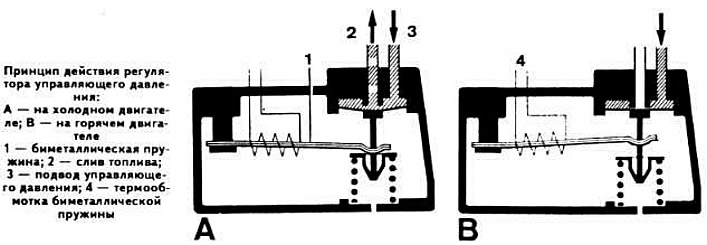The amount of air drawn into the intake manifold is measured by an air mass meter.
The air mass meter is installed in front of the throttle valve. It is equipped with a guiding device with a pressure disc mounted on a movable arm, which deviates depending on the air flow. The displacement of the pressure plate of the air mass meter is transmitted through the lever to the distributor plunger, which determines the amount of fuel in the system.

The composition of the fuel quantity distributor, in addition to the distribution plunger, includes a supply pressure regulator, a differential pressure valve that feeds the fuel line and six injection nozzles in accordance with the number of engine cylinders. When the pressure plate of the air mass meter is lifted, the distributing plunger of the fuel quantity distributor moves accordingly, opening its control edges for fuel access to the upper chamber of the differential pressure valve, separated from the lower chamber by a diaphragm. The fuel pressure and the force of the spring acting on the upper surface of the diaphragm are greater than the pressure on the lower surface of the diaphragm. As a result of this, the diaphragm moves down and opens the channels for supplying fuel to the injectors.
The supply pressure regulator maintains the fuel pressure in the system at a certain level and provides excess fuel to the drain line.
Auxiliary elements of the fuel injection system
The fuel filter is designed to clean the fuel circulating in the system.
The fuel accumulator is installed behind the fuel pump. It has damper and accumulative chambers, which are separated by a diaphragm.
In front of the diaphragm there is an additional partition with a disc valve that provides fuel supply to the system. A throttling hole for draining fuel is made in the partition.
After turning on the fuel pump, the storage chamber is filled with fuel and the spring diaphragm is stretched to the stop. When the engine is stopped, the tension of the diaphragm keeps the fuel under pressure and prevents the formation of fuel vapors, which makes it easier to start a hot engine.
Starting a cold engine and warming up the engine

To ensure the start and warm-up of the engine in the injection system «K-Jetronic» includes solenoid start nozzle, auxiliary air valve and control pressure regulator (heating corrector).
Electromagnetic starting nozzle
This nozzle is designed to inject additional fuel into the intake manifold at the time of starting a cold engine. It works in conjunction with a thermal time relay that controls its electrical circuit depending on the temperature of the engine and the duration of its start.
Auxiliary air valve
This valve is used to increase the frequency of the crankshaft during engine warm-up. When starting a cold engine, the additional air supply channel is opened by a rotary valve flap, which moves when the bimetallic spring is heated. As it warms up, the additional air supply channel gradually closes.
In addition, the supply of additional air is regulated by the pressure plate of the air mass meter, the movement of which leads to a corresponding rise in the distribution plunger, which also contributes to an increase in the crankshaft speed (with closed throttle).
Pilot pressure regulator
This unit enriches the working mixture entering the combustion chambers when the engine warms up. On a cold engine, a bimetallic spring compresses the diaphragm valve spring, opening the fuel drain channel. which leads to a decrease in resistance on the distributing plunger. A decrease in control pressure at a constant air flow causes an increase in the stroke of the pressure disc. As a result, the distribution plunger is additionally raised, increasing the amount of fuel supplied to the injectors.
As the bimetal spring heats up, the pressure on the diaphragm valve spring of the control pressure regulator decreases and the drain channel slowly closes. The control pressure reaches a normal value and the enrichment of the combustible mixture stops.
